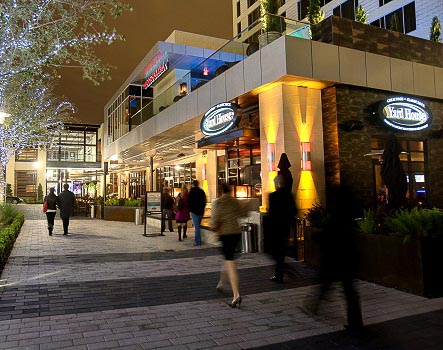Perhaps it should be obvious given their name, but mixed-use developments are rarely carbon copies of one another. Different topographies financing needs, market aims, and developer visions may make one mixed-use project look entirely different from another just across the street.
That flexibility is exactly what’s making mixed-use extremely popular among developers at the moment. At this spring’s Urban Land Institute conference in Houston, there were no less than a half dozen sessions devoted to mixed-use.
Beyond single projects, though, mixed-use trends are changing how we conceptualize the development of entire neighborhoods and even cities.
Can we call a suburban master-planned community that intentionally places homes, condos, retail, and office within a huge plot of land mixed-use? Or to receive such a label do projects need to be contained within a single large lot? What about an entire downtown? If architects lay out a comprehensive plan for a central business district (as ULI panelist Scott Johnson’s Johnson Fain did in Beijing) that includes several different uses, is it a mixed-use development?
That we can even ask these questions demonstrates just how pervasive the concept has become in both real estate development and urban planning. As urban and suburban residents call for more walkable neighborhoods – replete with homes, recreation, and work places – developers are responding with more and more mixed-use projects.
While these developments are often drastically different in scale and makeup, ULI panelists meeting in Houston argued that if they contain a set of key elements – at least three distinct uses, a connective green space, and the ability to allow users to live/work/play in same area – we should conceptualize of them each as mixed-use.
In their discussion of larger trends in mixed-use development, Jonathan Brinsden, CEO of Houston-based Midway Partners and Johnson, a partner at Los Angeles-based Johnson Fain, each highlighted green space and communal space as particularly important to the success of mixed-use developments today. “It’s the glue,” Johnson said.
Programming and social activities at these shared spaces draw people together. According to Johnson these open, public spaces also bring circulation, flow, and flexibility to developments, which allow them to adapt as consumers’ or residents’ needs change over time. Brinsden said that Houston examples at CityCentre and Kirby Grove, currently under construction, are places that offer users a chance to engage both physically and socially. “Wellness is more than fitness,” Brinsden said. It has community and social aspects.”
After showing that mixed-use developments are far more diverse in form than often considered, Brinsden and Johnson challenged the idea that a single-type of user – the millennial – represents the primary user of most mixed-use spaces. “If you build a great place, where people like to be, everybody will show up,” Brinsden said.
The same principle applies to mixed-use development in the suburbs, argued Les Newton of Houston-based Planned Community Developers, which often works in the Houston suburb Sugar Land, and Jim Carman of the Dallas-based Howard Hughes Corp. which has a stake in Houston suburb The Woodlands.
While we often do not think of suburbs as beacons of mixed-use development, Newton and Carman argued that unlike urban areas, suburban mixed-use projects have had to develop more slowly. Before adding commercial and office to suburban areas, most developers “wait for rooftops” in the residential areas to reach a threshold that makes those projects financially sustainable.
As suburban areas grow and become more urbanized, mixed-use areas are cropping up with greater frequency. While suburban mixed-use differs in shape from its urban counterparts, Lawson and Carman say an evolving definition of the term may be needed. A residential subdivision surrounded by a walking path and connected to retail and office by walkable and bikable streets should be considered a mixed-use form, in their estimation.
ULI speakers made it clear that there isn’t a one-size-fits-all template for mixed-use development -- or even for its definition. But it’s clear this form of growth isn’t going away. As Brinsden says, there’s just one word needed to summarize the future of mixed-use developments: “imperative.”

